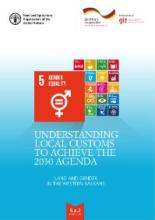Land Library Search
Through our robust search engine, you can search for any item of the over 73,000 highly curated resources in the Land Library.
If you would like to find an overview of what is possible, feel free to peruse the Search Guide.
/ library resources
Showing items 1 through 9 of 102.FAO and the Deutsche Gesellschaft für Internationale Zusammenarbeit (GIZ) GmbH have been providing support to the Western Balkans region to promote progress on Gender Equality, with a focus on measuring the proportion of countries where the legal framework guarantees women’s equal rights to land
From the outset, the development of agriculture has been strongly associated with women’s endeavour. In fact, women’s contribution to agriculture goes back to the origins of farming and the domestication of animals when the first human settlements were established more than 6 000 years ago.
This policy brief presents the main findings of a situational analysis and assessment of women’s and youth’s ability to access community land in Turkana County, Kenya, with a focus on their rights.
This paper reviews the experiences of introducing land consolidation and land banking instruments in Central and Eastern Europe, largely to address the structural problems of small and fragmented farms.
Ce document décrit le point de vue des parties prenantes sur le développement des Directives Volontaires pour la gouvernance foncière. Ces Directives représentent le plus grand «terrain d’entente» sur la gouvernance foncière qui a été trouvé à ce jour dans un forum mondial.
Este documento describe la perspectiva de las partes interesadas sobre el desarrollo de las Directrices voluntarias sobre la gobernanza de la tenencia.
This paper describes the perspective of stakeholders on the development of the Voluntary Guidelines on tenure. These Guidelines represent the greatest extent of “common ground” on governance of tenure that has been found to date in a global forum.
Improved access to gender-disaggregated data can be a catalyst to improving gender equality and provide opportunities for the so-called “Third Sector” of non-governmental and local organizations, especially those representing women.
The countries in Central and Eastern Europe began a remarkable transition from a centrally-planned economy towards a market economy in 1989 when the Berlin Wall fell and the Iron Curtain lifted.



